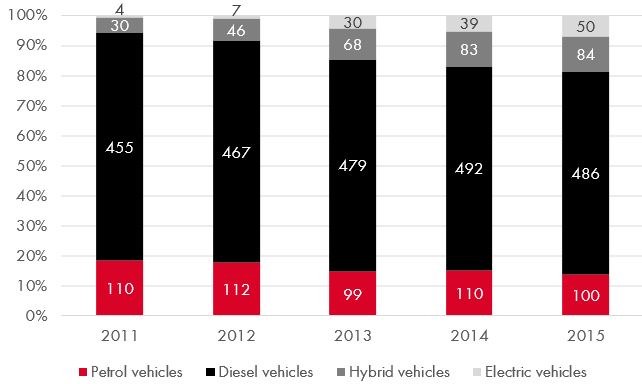Natural
We want to improve the environmental performance of our own parking facilities, our fleet, and our offices.
Q-Park is a large consumer of electricity, both for lighting and operational equipment and well as for charging electric cars. We have an energy-saving programme to raise awareness of our own energy consumption and to take measures to reduce this as well as our CO2 footprint. We express this footprint in terms of the CO2 emissions per parking space in an owned or long-leased parking facility.
Installing energy-saving lighting and optimising the lifts and ventilation control systems are the primary measures we take in our parking facilities.
We take other measures in our operating activities. For example, we select cleaner vehicles for our fleet and, when we need to travel, we use public transport more often and take fewer flights. By making use of modern communications technology, we can avoid unnecessary travel.
What we have achieved
The energy-saving programme has clear effects, in financial terms as well as in our environmental impact. We want to procure our energy on a larger scale by means of a central purchasing policy. Furthermore, we consume less energy due to the application of led lighting and dimming technology. In the period 2013 to 2015, we saved EUR 1,378,993 with these measures.
In Charles Street, Sheffield, Q-Park UK has established a showcase for smart led lighting solutions for PFs, with low-glare lighting and control technology. Visitors experienced parking here as safer and they find the garage brighter, while the lighting consumes 83 per cent less electricity.
Our average CO2 footprint per parking space in owned or long-leased facilities decreased from 152 kg in 2014 to 150 kg in 2015.

CO2 footprint per parking space per type of structure
- Scope 1: the emissions arising within the organisation rose from 3,027 tCO2 to 3,055 tCO2 due to the increase in number of cars in our in our fleet.
- Scope 2: the emissions outside the organisation rose from 28,277 tCO2 to 28,371 tCO2 due to greater electricity consumption in two countries – the Netherlands and the United Kingdom where the conversion factors to CO2 are the highest. In general, our electricity consumption dropped.
- Scope 3: other emissions decreased from 312 tCO2 to 293 tCO2. This is mainly due to fewer flights.
The number of electric cars in the fleet rose to 50 (in 2014 we had 39), and in parking facilities in Germany and Sweden we deployed more electrically driven cleaning machines.

Our fleet is becoming more sustainable
The number of flights decreased significantly because more business trips were made by train and, where possible, meetings were held via videoconferencing.

Number of flights
